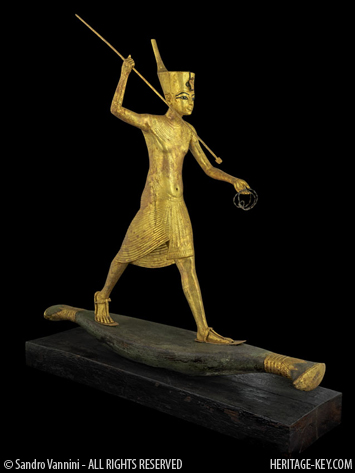 A massive one ton granite statue of the pharaoh Taharqa has been found in Dangeil, deep inside Sudan. Taharqa was a pharaoh of the 25th dynasty of Egypt. This was a period of Kushite rule, which means that Taharqa and his fellow rulers were from Nubia and drew their power-base from there.
A massive one ton granite statue of the pharaoh Taharqa has been found in Dangeil, deep inside Sudan. Taharqa was a pharaoh of the 25th dynasty of Egypt. This was a period of Kushite rule, which means that Taharqa and his fellow rulers were from Nubia and drew their power-base from there.
Update: Further information on the statue of Pharoah Taharqa discovered at Dangeil and a confirmation that – indeed – no statue of a pharaoh has ever been found further south of Egypt than this one in Owen’s follow up blog. You’ll also find photographs of the statues and inscriptions, as well as an interview with Dr. Julie Anderson.
The site is located approximately 350 km northeast of the modern Sudanese capital of Khartoum in the general vicinity of the fifth Nile cataract.
In addition to Taharqa, archaeologists have found statues of two other Napatan kings at the site- Senkamanisken and Aspelta. Neither of these rulers controlled Egypt.
The announcement was made on the blog of Dr. Caroline Rocheleau of the Royal Ontario MuseumNorth Carolina Museum of Art.A scholarly article was also publishedrecently in the journal Nubia & Sudan.
Thestatues were found in 2008 buttheir discoveryhas not been made public until now.
I contacted Dr. Rocheleau for an interview. She told me that dig director Dr. Julie Anderson, of the British Museum, will be handling media inquiries about the find howeverAndersonwill not be returning until January 6.
So we will have to wait a bit to get an interview and (hopefully) some pictures of the discovery.
In her blog Dr. Rocheleau describes the Taharqa statue as, more than life-size and weighs over one ton. TheTaharqa and Senkamanisken statueshave great muscular bodies with an inscribed back pillar… and lovely feet on the statue base, but we are missing their heads and their lower legs.
She continues, as for Aspelta, it completely the opposite: we have his beautiful head, lower legs and his feet, but not his body.
The find was a surprise to Rocheleaus team. There are no granite sources near the site and the finds at Dangeil, prior to this discovery, date tothe time of thekingdom of Meroe (3rd century BC 3rd century AD).





